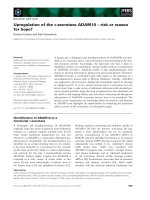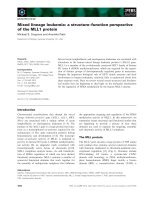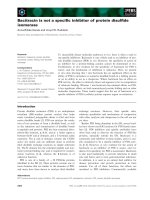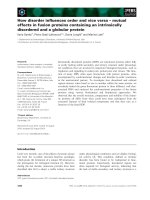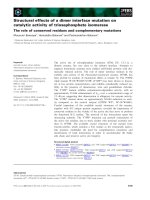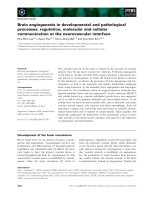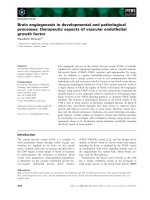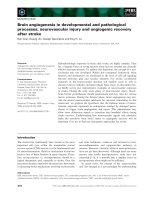Tài liệu Báo cáo khoa học: "VP Ellipsis in a DRT-implementation" pot
Bạn đang xem bản rút gọn của tài liệu. Xem và tải ngay bản đầy đủ của tài liệu tại đây (431.75 KB, 6 trang )
1 Introduction
VP Ellipsis in a DRT-implementation
Johan Bos
Department of Computational Linguistics,
Faculty of Arts, University of Groningen,
P.O.Box 716, 9700 AS Groningen.
Email:
Klein [Klein, 1986] introduced Predicate-DRSs for
the resolution of VP Ellipsis. In that approach a
Predicate~DRS (henceforth PDRS) serves as the rep-
resentation of a verb phrase, as will be shown in an
example now. Consider:
Nancy likes a cat.
(1) Betty does too.
This discourse is interpreted as meaning that Nancy
and Betty both like a cat (though not necessarily
the same cat). The source clause,
Nancy likes a cat,
parallels the target clause
Betty does too,
where the
subjects are parallel elements. The phrase
does too
represents a trace of the VP in the target clause.
Klein's treatment of (1) is shown in (2).
(2)
Xl Xs PI
Xl "- Nancy
[Yl] Y2
PI(xl): cat(ys)
like(y1
,Ys)
xs "- Betty
Pdx2)
In the second sentence of (1), a do-anaphor appears
that must be linked to a marker which has already
been introduced into the universe of the DtLS. The
value of this marker, which is P1, as we can see in (2),
is constrained by the conditions associated with the
previous VP in the discourse [Klein, 1986]. Following
Klein, we call
P1
a
predicate marker,
and the Sub-
DRS that is associated with Pt a
Predicate-DRS.
To
the domain of P1, a distinguished reference marker
Yl (indicated by square brackets) is added, which
plays the role of the individual, in this case xl which
is applied to the predicate. This application can also
be shown as a lambda expression:
(3) A Yl (cat(ys) A like (YhYs)) (xl)
In (2) the condition Ps(xs) in the main DRS will
apply the object xs to the predicate and solve the
do-anaphor in (1). The scope of marker Ys is de-
fined by the PDILS, instead of the main DRS, which
allows that Nancy and Betty do not necessarily like
the same cat.
But this same feature introduces a problem for pro-
noun resolution. This problem occurs when pro-
nouns refer to indefinite NPs which are in the uni-
verse of a PDRS and therefore inaccessible. Let us
give an example by considering the DRS (5) as the
translation of (4).
Nancyt likes a cats.
(4) She1 strokes its.
(5)
xl P1 P2
xl = Nancy
[Yl] Ys
P I (xi)I cat (Ys)
[ like(yl,y2)
[Y3]
Ps(xl): stroke(y3,?)
Since, in DRT, an anaphor can only refer to an-
tecedents from its own domain or from universes
that its DRS subordinates, the pronoun
it
cannot
be anaphorically linked to the indefinite description
a cat.
This means, in the situation of (5), candi-
date antecedents for
it
can only be found in the main
D1LS, since Pz is subordinated to it. The desirable
antecedent y2 in P1 is blockedJ
A solution to the problem of the indefinite descrip-
tions appearing in PDRSs, is to make them accessible
in the main DRS. This paper shows, by slightly mod-
ifying Klein's PDRSs, how that can be done, without
losing their desirable characteristics.
Firstly, we outline informally how indefinite descrip-
tions in PDRSs are made accessible. Then we show
how this idea relates to aspects like negation, disjunc-
tion, quantification and the strict/sloppy identity of
VP Ellipsis. Finally, we report about the implemen-
tation under development.
1Notice, that proper names and definite descriptions
do not give rise to this problem. In DRT, these are
usually added to the universe
of the
main DRS [Kamp
and Reyle, 1990] or
accommodated to
it [Van derSandt,
1992].
425
2 A new approach to
Predicate-DRSs
By treating a PDRS just as an ordinary DRS, with
the distinction that there is a correspondence be-
tween the arguments which are applied to the PDRS
and the members of its domain, it is possible to ex-
tend the scope of reference markers in a PDRS to
their superordinated DRS. The best way to show
how this works is to look at a DRS for (4) in this
new approach:
(6)
Xl X2
PI P2
X 1
Nancy
l
Yl Y2
P1 (xl ,x2):l cat(y2)
Ilike(yl,Y~)
P2(xl) stroke(y3,x~)
In (6), in the PDRS P1, Yl is linked to
Xl,
and y2
to x2. So, the difference here to Klein's approach is
that, besides the referent for the individual which is
applied to the PDRS,
all
indefinite descriptions in
the universe of the PDRS are associated with corre-
sponding arguments as well. 2 A lambda expression
for P1 in (6) is:
(7) A Yl A Y2 (cat(y2) A like(yl,y2)) (xl) (x2)
This treatment allows that we can refer to the indefi-
nite
cat, as
is done in P2 of (6). An added advantage
is that we maintain the original properties ofa PDtLS
outlined previously. Note, that the number of argu-
ments applied to a PDRS directly depends on the
number of indefinite descriptions in the VP. Conse-
quently, a VP with a ditransitive verb could yield
two indefinite descriptions, as in (8). Optional rela-
tive clauses can raise this number even higher (9).
(8) Nancy gives a man an iron.
Nancy likes a man who has an iron that
(9) a woman gave him.
3 Negation
Concerning predicate negation, we will assume that
the scope of negation does not embrace the subject
(cf [Kamp and Reyle, 1990]). The approach we take
2Therefore, it is not necessary to distinguish
them
with square brackets any more. Note that the agent cor-
responds
to
the first referent in the PDRS.
here is similar to standard DRT, because a new sub-
ordinated DRS affixed with a negation symbol is in-
troduced in case of negation. Let us consider (10):
(I0) Nancy1 doesn't own a cats.
* Shel beats it2.
Here we simply negate the predicate by constructing
the PDRS in a negated DRS. In (10) the pronoun
it
does not permit a link to the NP
a cat,
and this seems
to be the case in general as well, because negation
blocks anaphoric links. 8
Thus, in the case of a negated VP, the indefinites are
raised to the superordinated DRS which is the DRS
for negation. This construction is figured in DRS
(11) and causes exactly the result we wish:
it
cannot
be linked to
cat
because the referent for
cat,
x2, is
not accessible.
(11)
X1 P1
P2
xl Nancy
Ix2 [
-~ PI(Xl,X2):
Yl Y~
cat(y2)
own(yl ,Y2)
l y3
P2(xl): beat(y3,?)
Now consider (12), where an anaphoric link between
cat
and
it
is permitted. At first sight, this sentence
would appear as a counterexample to our character-
ization of negation. But it is not, if we interpret the
meaning of it as (13):
(12) Either Nancy doesn't own a cat,
or she beats it.
(13) Either Nancy doesn't own a cat,
or she does and she beats it.
An interpretation of (12) as (13) permits the acces-
sibility of cat in (12). In our DRT-framework with
PDRSs we easily can obtain a DRS for (12), as the
disjunction of two SubDRSs. Then, in one disjunct
predicate negation takes place, while in the other the
3However, [Kamp and Reyle, 1990] give as
a
possible
counterexample to this
generalization the discourse
Jones
does not llke a Porsche. He owns it,
interpreting it by
saying that there is some Porsche that Jones both dislikes
and owns. According
to me, such an interpretation seems
only
permitted if that Porsche is already uttered in
the
processed discourse.
426
do-anaphor is resolved, resulting in a accessibility for
the indefinite NP
a cat.
(14)
xl
PI P2
xl = Nancy
X2
Yl
Y2
"~ PI(Xl,X2): cat(y2)
own(yl ,Y2)
I
V
x3
P1(xl ,x3)
4 Quantification
In this section we will see how the quantifiers
every
and
no
can be treated. We will demonstrate how
quantification matches perfectly with our proposals
about PDRSs and negation. Sentence (15)
(15) Every woman likes a cat.
involves applying the quantified NP
every woman
to
the PDRS, visualized in DRS (16):
(16)
P1
X1
woman(xl)
I
X2
*
PI(xI,x2):
Yl Y2
cat(y~)
like(yl,y2)
Of interest here is that the argument of P1 is the
member of the antecedent DRS: xl. Also worth not-
ing is that the referent of the indefinite
a cat
in P1
is not raised to the main DRS but to the DRS that
holds the consequent of the implication relation. In
this case the NP
a cat
has narrow scope within the
quantified phrase every woman, and therefore not
accessible in the main DRS (as in standard DRT).
In a similar way the quantifier no is interpreted, us-
ing the logical equivalence of the formulae (17) and
(18):
(17)-,3z P(z) A
Q(x)
(18)YxP(z) *~Q(x)
The traditional way to translate
no
in DRT is based
on (17). 4 In this framework we use predicate nega-
4Several proposals have been made to treat gener-
alized quantifiers in DRT. Among them: [Klein, 1986;
Kamp
and Reyle,
1990; geevat,
1991].
tion combined with universal quantification, shown
in (20), which is the translation for (19).
(19) No woman likes a dog.
(20)
P1
Ix2 {
xl 1 Yl Y2
woman(xl)
]""
PI(Xl,X2) dog(y2)
like(yl,y2)
This way of dealing with quantification is exactly
what we need for VP Ellipsis resolution. A discourse
as in (19) could proceed with a sentence like:
Bat
Peter does, and he beats it,
which is an example of a
'missing antecedent' [Hankamer and Sag, 1976], since
the pronoun
it
lacks an overt antecedent because the
NP
a dog
is in the scope of negation and therefore
not accessible. By generating a condition in D1LS
(20) applying
Peter
to the PDRS PI, the 'missing'
antecedent is found (21).
iX3 X4
X1
(21)
P1 P2
woman(xi)
x3 = Peter
PI(X3,X4)
P2(x3) t :;at(y3,x4)
I
x2(
)
"~ PI Xl,X2 :
Yl Y2
dog(y2)
like(yl,y2)
Summarizing so far, we have shown that PDRSs,
with the ability to raise indefinite descriptions to its
superordinated DRS, can be used quite effectively in
our framework. Mainly, we distinguished two cases
where referents of indefinite descriptions were not
raised to the main DRS, but to a DIgS subordinated
to the top level. The first case concerns predicate
negation, where a negated DRS is superordinated to
the PDRS involved. The second case concerns quan-
tification, where the PDRS is subordinated to the
consequent-DRS of the implication relation.
5 Strict and Sloppy Readings
This section shows how sloppy and strict readings
arising in VP Ellipsis are obtained. Discourses like
(22) are ambiguous as to whether Betty strokes
427
Nancy's cat (the strict reading) or Betty strokes
Betty's cat (the sloppy reading).
(22) Nancy strokes her cat.
Betty does too.
Following [Van der Sandt, 1992], presuppositions are
accommodated to the preceding discourse. That is, if
discourse does not provide an antecedent, one will be
created. In processing the first sentence of (22), DRS
(23) is obtained, where the presuppositional posses-
sive construction her cat is paraphrased in a dashed
DRS to indicate information for accommodation.
(23)
xl P1
X 1
"
Nancy
Yl
stroke(y1 ,y~)
Yy2 P i
Zl Z2 !
P(Y,Y2): cat(z~) 1
poss(zl ,z2)
In the approach of [Van der Sandt, 1992] the
anaphoric material in the dashed DRS is resolved
after merging the DRS constructed for the sentence
with the main DRS, resulting in a new DRS that
contains no anaphoric material for accommodation
still to be processed. This procedure is followed for
(23) yielding DRS (24).
xl x2 P1 P2
xl = Nancy
Z1
Z2
P2(XI,X2) I cat(z2)
(24) [ poss(zl ,z2)
PI(X1) t
Y[!!ir !!!i!! ! !!!i!iii
Discourse (22) provides one suitable antecedent for
the possessor, namely Nancy, and Nancy possesses a
cat is established in the DRS. But this gives us only
the strict reading when in case of an elliptical VP in
the proceeding discourse is referred to P1, which is
the case in (22).
To represent the sloppy reading, the anaphoric ma-
terial in (23) that holds the presupposition must not
be resolved at the stage of DRS-merging, but left
there to provide accommodation another time (with
other constraints, that depend on the antecedent of
the possessor). In this way both the strict and sloppy
reading are obtainable in case of VP Ellipsis.
We show this proposal with our example (22), cor-
responding with DRS (25). Similar to (24), the pre-
supposition causes an antecedent to be created (i.e.
Nancy possesses a cat), with this difference, that the
anaphoric material is not resolved. The VP-anaphor
finds as an antecedent PI: strokes her cat. The pre-
suppositional material in the dashed DRS can now be
accommodated to two different antecedents: Firstly,
Nancy, where no antecedent has to be created for the
possessive construction, resulting in the strict read-
ing. Secondly, the newly introduced Betty, where in
that case the presupposition Betty possesses a cat
is accommodated and the sloppy reading can be de-
rived. The latter is shown in (25):
(25)
xl x2 xa x4 P1 P2 P3
xl : Nancy
Zl Z2
P2(Xl,X2)
cat(z2)
poss(zl,z2)
Pl(xl):
Yl
stroke(y1 ,Y2)
YY2 P
Zl z2
P(Y,Y2):I cat(z2)
.
I
xa = Betty
Zl z2
Pa(x3,x4): cat(z2)
poss(zl ,z~)
Pl(Xa)
If we compare this approach to the higher-order uni-
fication approach to VP Ellipsis of [Dalrymple et al.,
1991], we can obtain all six readings of the compli-
cated (26) generated by the equational analysis of
[Dalrymple et ai., 1991].
ore John revised his paper before the
~v/teacher did, and Bill did too.
The reading of (26) where John, the teacher, and
Bill all revised John's paper, is translated in a DRS
with the presupposition that John possesses a paper
428
accommodated to the main DRS. The reading where
John and Bill revised their own papers before the
teacher revised John's paper, causes accommodation
twice, once for
John possesses a paper
and once for
Bill possesses a paper.
The other readings can be
obtained analogously.
6 Implementation
The PROLOO-implementation is a natural language
processing system which parses simple discourses,
The way DRSs are constructed in this system will
be discussed concisely.
The emphasis of the implementation lies on anaphora
resolution (like do-anaphora and pronouns) in a do-
main of a small fragment of English. A parse of a
typical discourse is:
> Mary likes a cat.
> She does not beat it.
> John does not either.
drs
:
[ xl x3 x6 p2 p5 ]
[ x l = mary
p2(xl,x3):[ y x4 ]
[ cat (x4)
like(y,x4) ]
not
£ 3
£ pS(xl):£ y ]
[
beat(y,x3)
] ]
x6 =
john
not [ ]
£ pS(x~) ] ]
This implementation differs from other PROLOG-
implementations of DRT (e.g. the threading ac-
count of [Johnson and Klein, 1986]) in the way it
constructs DRSs. Following lasher, 1990], DRSs
are constructed in a bottom-up fashion, using A-
conversion.
Each lexical entry is associated with a SubDRS, rep-
resenting the meaning of that entry. For instance,
the lexical entries for
a, man,
and
runs
are:
lex(ap
det
: [agr=sing,
def=ind,
drsffi (X'P) "(X'Q) "drs( [2, [P ,Q] )3 ).
lex
(mSll
m
noun:
[agr=sing,
~s=X'~s ( [X],
[man(X) 3 ),
gender male,
refffiX] ).
lex (runs,
iv: [agrfsing,
drsfX'drs ( D, [do(P ,X) :drs ( [y], [run(y)] )] ),
reffP] ).
As these entries make clear, a DtLS is constructed of
a PROLOG term containing two lists, where the first
one contains the discourse markers (i.e. the domain)
and the second one the constraints (these are repre-
sented as
PROLOG
terms). Furthermore, the lambda
abstractor is constructed as the PROLOG operator '^'
(this idea is taken from [Pereira and Shieber, 1987]).
While parsing a sentence, the DtLS for that sen-
tence is processed by A-conversion and merging, us-
ing syntax rules of the following form 5 (as in [Al-
shawl, 1992]):
np:[drs=Drs,agr=Agr ] >
[det:[drs=A2"Drs
],
noun:[drs=Al,agr=Agr ],
optrel:[drs=Al'A2, ]].
The output of a sentence parse is a constructed DRS
for that sentence, but with referring expressions (if
any) still unresolved. This sentence-DRS then is
merged with the ingoing DRS, representing the com-
puted discourse so far. During this merge, the fol-
lowing computing actions take place:
• Computing of arguments for PDRSs;
• Resolving of Pronouns and'VP Ellipsis;
• Accommodation of Proper Names, Definite De-
scriptions, and Possessive Constructions.
An aid to these computations is a historylist com-
puted during the sentence parse. This historylist
contains all the items that are represented in the dis-
course, extended with information that is not purely
semantic, such as type and gender of certain sub-
jects, but necessary for the computations mentioned
above.
This results in a new DRS, capturing the entire dis-
course, which will be the ingoing DtLS for the merge
after the next sentence is parsed.
7 Conclusion
By slightly changing Klein's treatment of Predicate-
DRSs, that is making indefinite descriptions occur-
ring in the scope of the VP accessible to the top level
of the main DRS, we obtain a much better mecha-
nism for handling VP Ellipsis in DRT without losing
any old characteristics in the theory. Furthermore,
we proposed to use Van der Sandt's theory on pre-
suppositions in a different way in our framework to
SFor reasons of clarity, some information in these rules
is omitted.
429
derive both strict and sloppy readings where possi-
ble.
This presentation is informal. Formal definitions of
this approach, and a comprehensive description of
the PROLOG-implementation can be found in the au-
thor's Master thesis under preparation, to appear in
August 1993.
Acknowledgments
I would like to thank Peter Blok, Gosse Bouma,
Robin Cooper, Ronald Klopstra, John Nerbonne,
Gertjan van Noord, Elni Rigas, and the referees for
their helpful and supportive comments on earlier ver-
sions of this paper.
References
[Alshawi, 1992] Hiyan Alshawi, editor. The Core
Language Engine. The MIT Press, 1992.
[Asher, 1990] Nicholas Asher. Themes in Discourse
Representation Theory. Second European Summer
School in Language, Logic and Information, 1990.
[Dalrymple et al., 1991] Mary Dalrymple, Stuart M.
Shieber, and Fernando C.N. Pereira. Ellipsis and
Higher-Order Unification. Linguistics and Philos-
ophy, 14:339-452, 1991.
[Hankamer and Sag, 1976] Jorge Hankamer and
Ivan Sag. Deep and surface anaphora. Linguis-
tic Inquiry, 7(3):391-428, 1976.
[Johnson and Klein, 1986] Mark Johnson and Ewan
Klein. Discourse, Anaphora, and Parsing. In Coi-
ing, 1986.
[Kamp and Reyle, 1990]
Hans Kamp and Uwe Reyle. From Discourse to
Logic; An Introduction to Modeltheoretic Seman-
tics of Natural Language, Formal Logic and DRT.
Kluwer, Dordrecht, 1990.
[Klein, 1986] Ewan Klein. VP Ellipsis in DR Theory.
Studies in Discourse Representation Theory and
the Theory of Generalised Quantifiers, 1986.
[Pereira and Shieber, 1987] Fernando C.N. Pereira
and Stuart M. Shieber. Prolog and Natural-
Language Analysis. CSLI, Stanford, 1987.
[Van der Sandt, 1992] Rob Van der Sandt. Presup-
position Projection as Anaphora Resolution. Jour-
nal of Semantics, 9:333-377, 1992.
[Zeevat, 1991] Hendrik Willem Zeevat. Aspects of
Discourse Semantics and Unification Grammar.
PhD thesis, University of Amsterdam, 1991.
430

